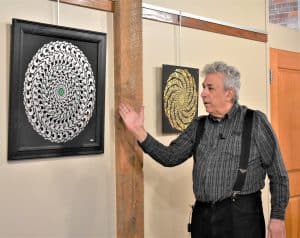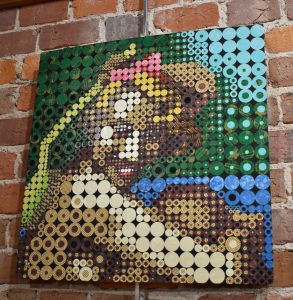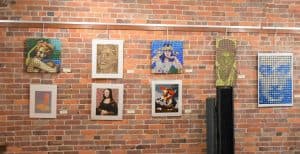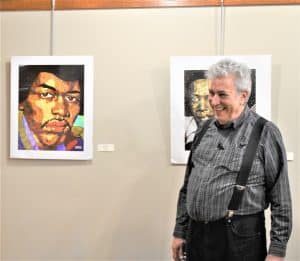calsfoundation@cals.org
Last Days to See the Dazzle and Glamour of Byron Werner’s Art
 Shiny. Mysterious. Opulent. Old Hollywood. Intriguing. These are just a few words that may come to mind when you walk through the Bookstore at Library Square, where Byron Werner’s art exhibition is in its closing days. The show will close at 5:00 p.m. on Halloween night, this Thursday, October 31. Don’t miss this last chance to see it!
Shiny. Mysterious. Opulent. Old Hollywood. Intriguing. These are just a few words that may come to mind when you walk through the Bookstore at Library Square, where Byron Werner’s art exhibition is in its closing days. The show will close at 5:00 p.m. on Halloween night, this Thursday, October 31. Don’t miss this last chance to see it!
The artist recently gave us a personal tour of his show that was as alluring and multifaceted as the work itself.
Byron Werner has been creating art in Little Rock for about 15 years. Before that he had a long career working in Hollywood on special effects for such films as Star Wars, Titanic, and Honey I Shrunk the Kids. He is multi-talented, having also hosted a radio show despite having to overcome a stutter which is now hardly ever noticeable. His genial and humorous approach to talking about his art is all the more interesting because his work can be technically intricate despite its surface charm. Like Werner, his artworks have both instant charisma and a deeper intelligence that lies beneath their construction.
His interest in technique, pattern, and number emerges in his explanation of his op art pieces, which range from the Mona Lisa (re-imagined) to Theda Bara in Cleopatra. After describing the geometrical choices and interlocking patterns that create his mosaic-like op art, Werner quips about his Mona Lisa, “Up close, she’s a monster, but you get back and she kinda works.”

The same is true for all the op art pieces: from a very close view, they look like abstract scatterings of shapes. But when a viewer steps back and looks at the whole wall of works from twelve feet away, the pieces come into focus as photorealistic portraits. The effect could be a meditation on pixelation, but the technique is much more than that in Werner’s hands.
He explains why he chose Joan Blondell for one of his op art muses. “Op art can be very dry and technical in its subjects, and for this piece, I wanted a subject that was warmer and softer.” His color choices make the success of that artistic goal clear, with warm yellows and blues softening the mosaic effect.
Another op art piece hangs across from the others: it is a massive quilt about 8 feet by 12 feet. Werner worked in tandem with quilter Wilma Richter to produce the pieced artwork. When he designs patterns for quilters, he creates six different-colored squares or shapes to compose the image. He described with relish the process for the Richter quilt, as he knows the quilter personally and gave her a surprise by concealing the nature of her project until the end.
“I told her, ‘You choose the colors, 3 dark and 3 light, but I’m not going to tell you what it is!’” Werner said, smiling with a gift-giver’s glee. “So she put all the work in without knowing, and finally stood back and saw her favorite TV actor, James Arness from Gunsmoke! So she was very happy.”
The Richter quilt is so big that Werner learned that he either needs to design smaller quilts or find larger surfaces for display. “To see that image properly in your home, you’d have to stand all the way across the house,” he said. “What I’d really like is a 2-story wall somewhere.”

Other pieces by Werner take their inspiration from literary figures. His portrait of H.P. Lovecraft, master of horror, was originally designed on color-changing paper, as Werner explained while standing beside a print reproduction. “In the original, if you stand on this side, he looks all pink and beige,” Werner said. “But over on the other side it changes to metallic green and blue, like he’s some sort of monster or has an alien infection.” The tidbit is a perfect example of why artist talks bring much more depth to an exhibition, particularly a show that uses prints as well as originals. Knowing the cleverness of Werner’s initial artistic concept is an added pleasure even when viewing a reproduction of the original work.
But that’s not all, because sometimes the artist also has stories about what happened to the artwork after he created it. One very large portrait of Timothy Leary (countercultural figure known for his LSD experimentation) took months to create. During that time, Werner said he didn’t even know if it would work due to the complexity of the interlocking spiral pattern. “I had to use 3 colored pencils just to keep track of all the layers. Once again, I invented a new way to make it more complicated for myself!” he said with his characteristic good humor.
Now, that original work belongs to the personal collection of actor Leonardo diCaprio’s father, George DiCaprio. The star and his father had apparently been considering making a Leary movie at one point, and they liked the Werner portrait of Leary so much they wanted to keep it.
 Inventive and technically diverse as Werner’s portraiture is, his work takes still more forms. Beautiful and unusual mandalas by Werner also hang in the Bookstore, some based on odd, prime number patterns like 11, 13, or 17. Werner described why he chose these nonsymmetrical, “chaotic” numbers as opposed to the more even and rhythmic fours or sixes or nines. He wanted the less-balanced numbers to reflect the noise and confusion of today’s culture, out of which his mandalas can still find their own balance and stillness.
Inventive and technically diverse as Werner’s portraiture is, his work takes still more forms. Beautiful and unusual mandalas by Werner also hang in the Bookstore, some based on odd, prime number patterns like 11, 13, or 17. Werner described why he chose these nonsymmetrical, “chaotic” numbers as opposed to the more even and rhythmic fours or sixes or nines. He wanted the less-balanced numbers to reflect the noise and confusion of today’s culture, out of which his mandalas can still find their own balance and stillness.
Don’t miss the last chance to enjoy in person the curious, smart glamour of the works of Byron Werner. A full video of Werner’s art talk will be available soon, but the art itself will only be on view through 5:00 p.m. Thursday (Halloween).
Stop by the Bookstore and see Werner’s show before it is gone! And while you’re there, enjoy our deeply discounted prices on popular used books and literary gifts, or have lunch with a friend at Jimmy’s Serious Sandwiches, where you’ll find healthy gourmet food, fast.
Article by Rosslyn Elliott



